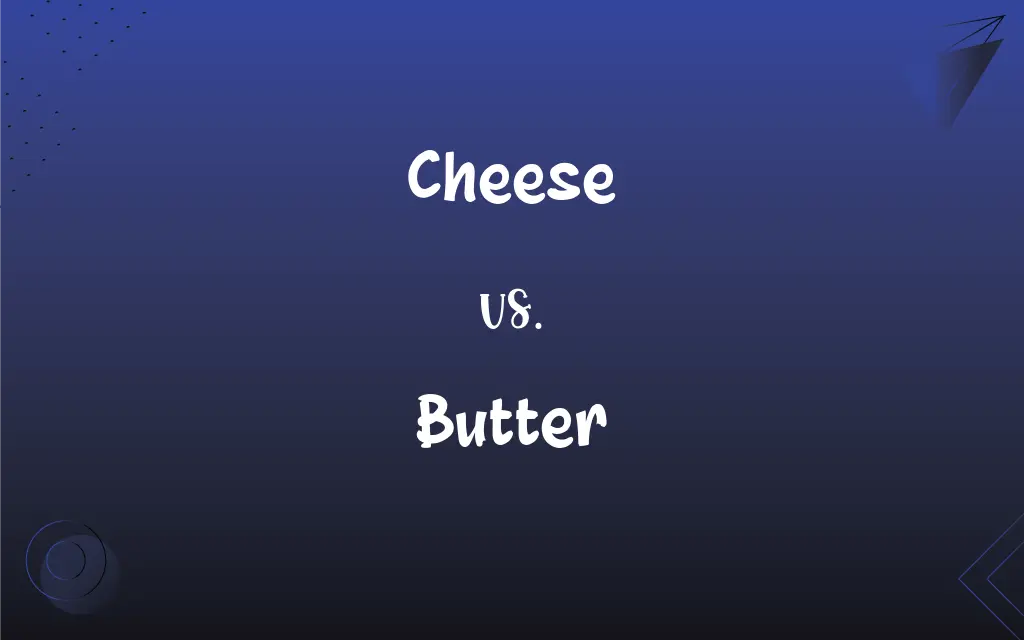Cheese vs. Butter: What's the Difference?
Edited by Aimie Carlson || By Harlon Moss || Updated on October 6, 2023
Cheese is a dairy product made from milk, distinguished by a wide range of textures and flavors, whereas butter is a dairy product consisting of approximately 80% butterfat, widely used as a spread and cooking fat.

Key Differences
Cheese, encompassing a spectrum of textures and flavors, is derived from the coagulation of milk proteins. Butter, on the other hand, is a rich, creamy dairy product made by churning cream until it reaches a semisolid state. Both stem from milk but are achieved through distinct production processes.
In the realm of cuisine, cheese is not only a standalone food item but also a condiment, often used to enhance the flavor of dishes with its savory, sometimes pungent, characteristics. Conversely, butter, while sometimes enjoyed on its own as a spread, is ubiquitously recognized as a cooking and baking essential, contributing to the rich, moist texture of various culinary creations.
When considering nutritional profiles, cheese can offer a substantial amount of protein and calcium, its content largely influenced by the variety and preparation method. Butter predominantly provides fats, specifically saturated fats, and can contain vitamins like A and D, offering a dense caloric content with minimal protein.
cheese, depending on its type, may require specific storage conditions and generally possesses a shorter shelf life than butter, especially once opened. Butter, typically resilient to longer storage, is often refrigerated or even stored at room temperature for short periods, provided it is kept in an airtight container away from light.
In cultural contexts, cheese and butter are celebrated differently. Cheese might be the star of various festivals, tastings, and pairings, its vast assortment of types offering a journey through various regional specialties. Butter, whilst perhaps less frequently exalted in a similar manner, holds a foundational role in culinary traditions, symbolizing richness and indulgence in numerous cultures.
ADVERTISEMENT
Comparison Chart
Basic Definition
A dairy product derived from coagulated milk proteins.
A dairy product obtained by churning cream.
Uses in Cooking
Used as a condiment or standalone food item.
Commonly used as a cooking fat or spread.
Nutritional Content
Rich in protein and calcium, variable by type.
High in fats, especially saturated fat, and may contain vitamins A and D.
Shelf Life and Storage
Generally has a shorter shelf life and may require specific storage conditions.
Tends to have a longer shelf life and is often refrigerated or kept at room temperature for short periods.
Cultural Significance
Celebrated for its myriad of types and regional specialties.
Valued as a foundational, rich, and indulgent element in culinary traditions.
ADVERTISEMENT
Cheese and Butter Definitions
Cheese
It can also be a processed product, often sold in slices and used for sandwiches and cooking.
She placed a slice of processed cheese into her sandwich for a quick, melty treat.
Butter
Butter is a dairy product made by churning cream until it reaches a semi-solid state.
She spread a generous layer of butter on her warm toast.
Cheese
Cheese is a versatile dairy product, solidified from milk, with numerous varieties characterized by different textures, flavors, and forms.
The gourmet cheese platter featured an eclectic mix of flavors and textures, from creamy brie to pungent blue cheese.
Butter
Butter is sometimes flavored with ingredients like garlic or herbs, providing an infused spread for bread and cooking.
She smothered the freshly baked bread with garlic-infused butter, enhancing its savory allure.
Cheese
It’s commonly utilized in various culinary contexts, as a topping, filling, or standalone snack.
Sprinkling grated Parmesan cheese on the pasta elevated its savory profile.
Butter
Butter can be clarified, meaning it is melted and separated from its milk solids, to produce ghee.
By clarifying the butter, she made ghee, which had a nuttier flavor and a higher smoke point.
Cheese
Cheese is often paired with wine, crackers, and fruits in culinary experiences and events.
The wine and cheese event offered an opportunity to explore harmonious pairings between various cheeses and wines.
Butter
It's often used as a cooking fat in various culinary applications, such as sautéing or pan-frying.
He melted butter in the pan before adding the eggs, ensuring they didn't stick and had a rich flavor.
Cheese
Cheese can be aged for different periods, resulting in variations from young, soft cheeses to aged, hard cheeses.
The aged cheddar had a sharp, robust flavor, indicative of its extended maturation period.
Butter
It's a common ingredient in baking, often used to add moisture, flavor, and texture to baked goods.
Adding butter to the cookie dough made it rich and tender.
Cheese
A solid food prepared from the pressed curd of milk, often seasoned and aged.
Butter
A soft yellowish or whitish emulsion of butterfat, water, air, and sometimes salt, churned from milk or cream and processed for use in cooking and as a food.
Cheese
A molded mass of this substance.
Butter
A spread made from fruit, nuts, or other foods
Plum butter.
Cashew butter.
Cheese
Something resembling this substance in shape or consistency.
Butter
A vegetable fat having a nearly solid consistency at ordinary temperatures.
FAQs
How is butter produced?
Butter is produced by churning cream until it separates into solid butterfat and liquid.
Is cheese a good source of protein?
Yes, cheese is typically a good source of protein.
Are there different types of cheese?
Yes, there are numerous types of cheese, varying in texture, flavor, and aging process.
What is cheese made from?
Cheese is made from milk, using a process that involves coagulating the milk proteins.
Is butter gluten-free?
Yes, pure butter is gluten-free.
Can butter be stored at room temperature?
Yes, butter can be stored at room temperature for short periods if kept in an airtight container.
Can butter be used for frying?
Yes, butter can be used for frying, but it has a lower smoke point than some oils.
What is vegan cheese made of?
Vegan cheese is often made from nuts, soy, or other plant foods.
Can you freeze cheese?
Yes, some types of cheese can be frozen, although it may affect texture and flavor.
Are there non-dairy substitutes for butter?
Yes, there are numerous non-dairy butter substitutes, including those made from coconut oil, olive oil, and more.
How is blue cheese made?
Blue cheese is made by introducing cultures of the mold Penicillium to form distinct blue veins or spots.
Is ghee a type of butter?
Ghee is clarified butter, made by separating and removing the milk solids from butter.
Can butter be made from milk other than cow’s milk?
Yes, butter can also be made from the milk of goats, sheep, and other mammals.
Can cheese be lactose-free?
Some cheeses, especially aged varieties, contain low to negligible lactose levels.
Is cheese fermented?
Yes, cheese is a fermented product, created by the action of bacteria or enzymes on milk proteins.
Can cheese be made at home?
Yes, certain types of cheese can be made at home with the right ingredients and conditions.
Is butter considered a healthy fat?
Butter contains saturated fat, which should be consumed in moderation according to dietary guidelines.
How should cheese be stored?
Cheese should generally be stored in the refrigerator, wrapped to prevent drying out.
What is cultured butter?
Cultured butter is made from cream that has been fermented with specific bacteria before churning.
What is margarine?
Margarine is a butter substitute, typically made from vegetable oils.
About Author
Written by
Harlon MossHarlon is a seasoned quality moderator and accomplished content writer for Difference Wiki. An alumnus of the prestigious University of California, he earned his degree in Computer Science. Leveraging his academic background, Harlon brings a meticulous and informed perspective to his work, ensuring content accuracy and excellence.
Edited by
Aimie CarlsonAimie Carlson, holding a master's degree in English literature, is a fervent English language enthusiast. She lends her writing talents to Difference Wiki, a prominent website that specializes in comparisons, offering readers insightful analyses that both captivate and inform.































































